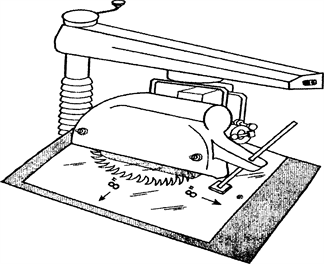PDFWAC 296-806-48030
Guard radial saws.
(1) You must make sure the radial saw has a hood that does all of the following:
(a) Completely encloses the upper portion of the blade down to a point that includes the end of the saw arbor.
(b) Protects the operator from flying splinters and broken saw teeth.
(c) Deflects sawdust away from the operator.
(2) You must provide a lower blade guard that does all of the following (see Guard radial saws, illustration 480-2):
(a) Guards the sides of the lower exposed portion of the blade to its full diameter.
(b) Automatically adjusts to the thickness of the stock being cut.
(c) Remains in contact with the stock to provide the maximum protection possible for the operation being performed; or
(d) Is manually adjusted (wing) guard that:
(i) Is made of material strong enough to withstand the forces put on it.
(ii) Suggested materials include polycarbonates or expanded metal.
(iii) Has edges that are smooth so no hazards from the guard exist.
(iv) Extends a minimum of eight inches to both the front and arbor-end sides.
(v) Is adjustable in a vertical plane to the different thicknesses of stock so the gap is three-eighths inch or less between the bottom of the guard and the top of the stock.
EXEMPTION: | Saws may be guarded with a fixed enclosure, fixed barrier guard, or a manually adjusted guard when specific conditions prevent using a standard, automatic adjusting guard. Alternative guards have to both: |
1. Provide protection equivalent to a standard automatic adjusting guard; and | |
2. Be used according to the manufacturer's instructions with sufficient supervision to meet this requirement. |
Illustration 480-2 Guard radial saws
A manually adjusted awareness barrier guard that
extends 8 inches to the front and sides of the blade
 |